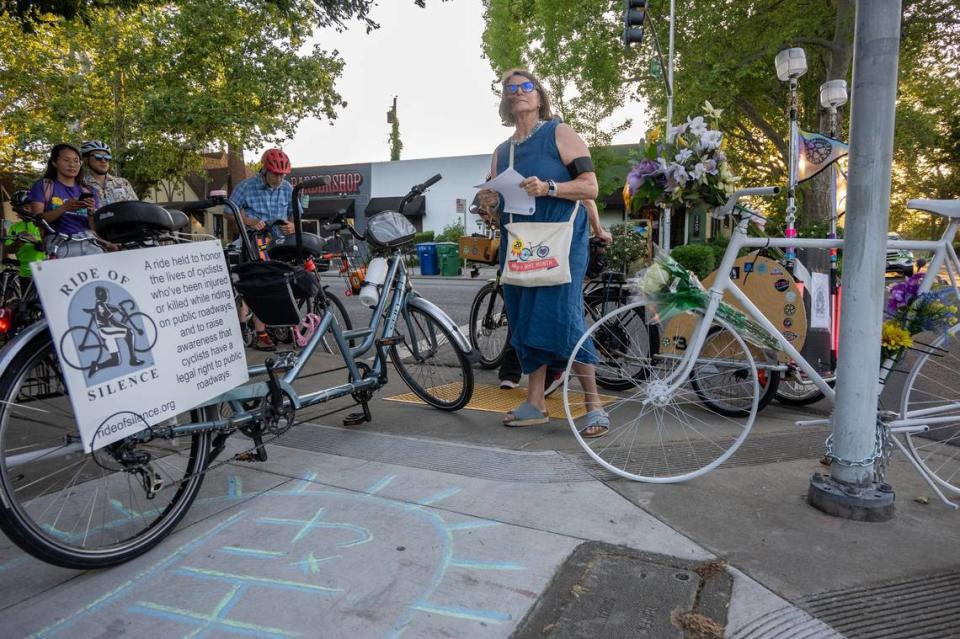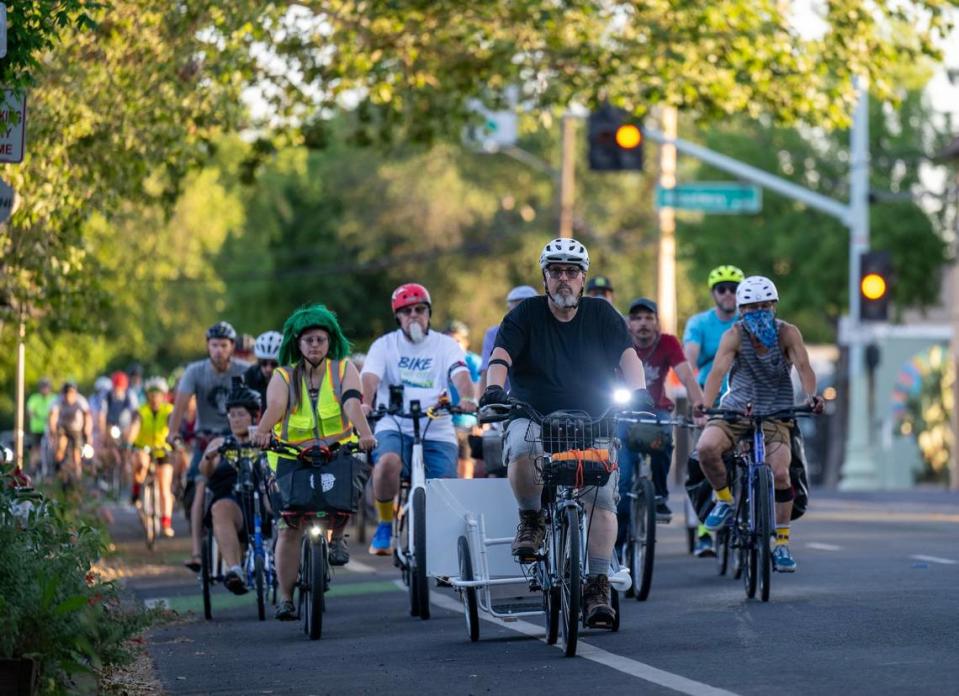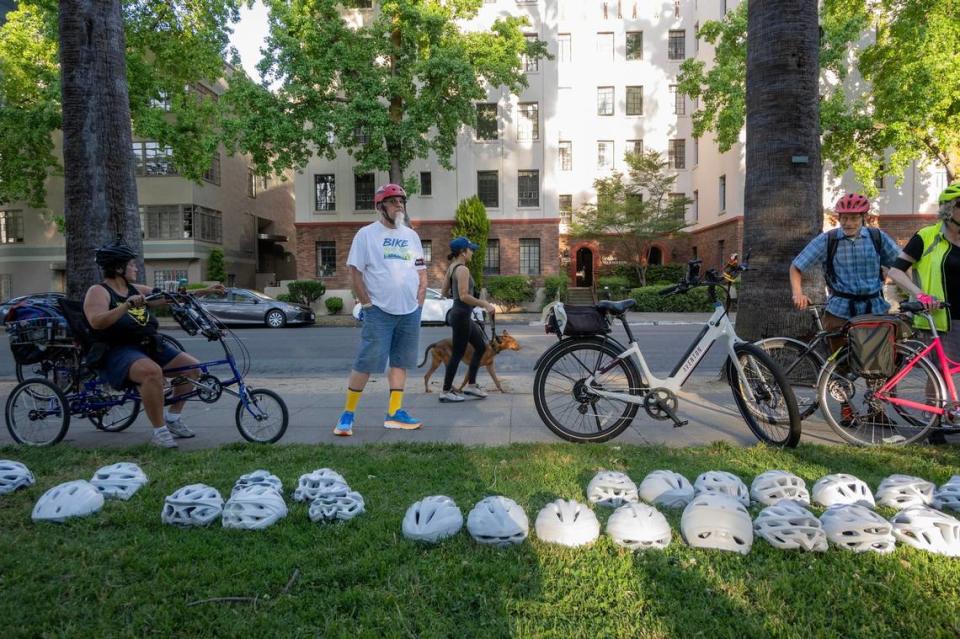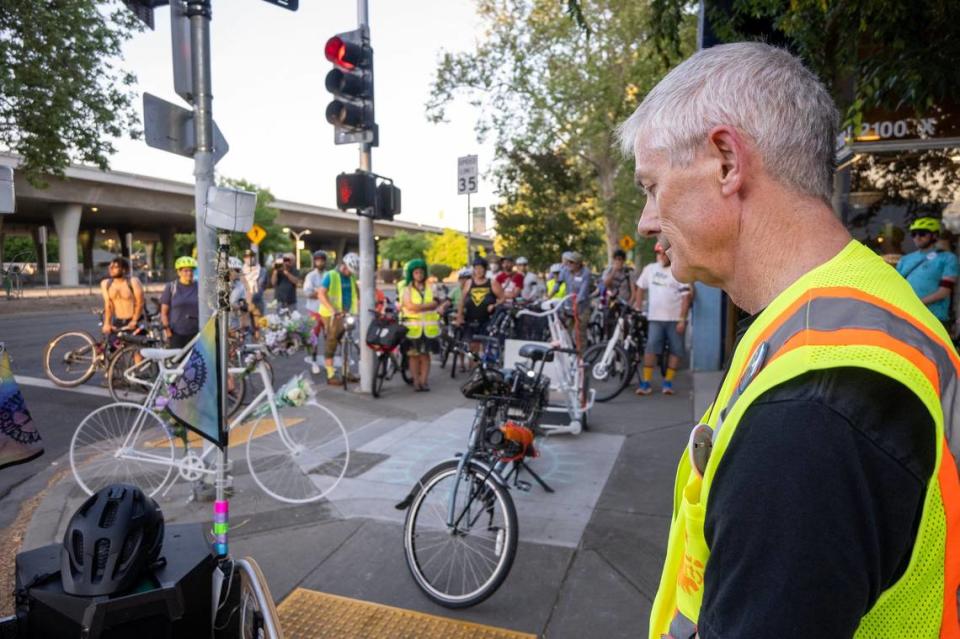On Ride of Silence, memories of cyclist fatalities meet push for safer Sacramento roads
Memorials by the side of the road took on new depth during an eerie, silent Wednesday bike ride through Sacramento that toured sites of fatal crashes.
The all-white “ghost bike” locked to the post at 21st and X streets? Leaders of the Ride of Silence broke the quiet to collectively acknowledge with around 30 cyclists that it was for Kate Johnston. The lawyer was fatally struck at that intersection in January. She loved to take her teenage son on fishing trips. She was 55.
The ghost bike at 10th and H streets? That’s where Trevor Caine Micarelli was hit and killed on his bike in 2016. His mother called him “Ma’s sunshine, her handsome boy and the best of her.” He was 28.
The significance of these cyclist deaths resonated uncomfortably for the riders themselves, who all knew how dangerous the capital region’s transportation network could be.
The city acknowledges that inadequacy, too. Research has shown that the vast majority of deadly collisions are preventable. Seven years ago, city leaders made a “Vision Zero” pledge to eliminate all traffic fatalities and serious injuries by 2027 among all types of road users.
Vision Zero is an international movement, an effort more than a decade in the making across American cities, that emphasizes cooperative efforts between government, advocacy groups, residents and others to make streets safer for all users, notably pedestrians, cyclists and drivers.
Although Sacramento has taken steps to improve infrastructure in line with its Vision Zero promise, including the installation of many parking-protected bike lanes in the city center, it is far from curbing traffic deaths.
This year, The Sacramento Bee has previously reported that Johnston, Mattie Nicholson, Jeffrey Blain, Aaron Ward, Sam Dent, Terry Lane and David Rink all died while biking or walking on city streets.
The Sacramento County coroner, Rosa Vega, confirmed Thursday that James C. Lind, another pedestrian, was killed on Fruitridge Road April 9. He was 54.
Nicholson and Johnston, the cyclists among the dead this year, were both using streets with unprotected bike lanes that left them vulnerable to passing vehicles. And, like all the other dead cyclists and pedestrians, they were fatally struck on roads that city staff have already identified as dangerous.

Despite the mounting death toll, elected officials may not direct much funding toward safe streets amid a budget deficit.
The “high-injury network” is still hazardous, and the Active Transportation Commission made nine recommendations in their 2022 report to the City Council to improve safety for all road users, including drivers. Council members on the Budget and Audit Committee said last week that it would be difficult to allocate the $10 million the commission needed in the first year to fund all its recommendations.
As cyclists continue to get struck and killed in the city, the Ride of Silence goes on.
Don Gibson, a South Natomas resident who serves on the commission, recited a statistic to the crowd gathered at Capitol Park before the trip began.
Far too many people get injured in traffic collisions — and, he added, traffic deaths are more frequent than homicides.
He read off the names of seven people who have died in crashes this year.
“Those people that die in traffic violence,” Gibson said, “hardly get the attention they deserve.”
Jeff Parkin, a videographer who’s led the Ride of Silence for five years, is trying to change that.

A death by City Hall
Parkin began leading the memorial event a few years after he first participated.
“I was deeply moved by the ride,” he said about his feelings after participating in his first Ride of Silence. He’d helped design routes for Bike Party Sacramento — a more joyful affair — “and so I used what I learned there to plan this route.”
The ride looped from the state Capitol down to X and 21st streets, back up to the heart of midtown at 24th and J and over to an improved intersection where Carlson and State University drives meet with J Street, the doorstep of Sacramento State. It continued and back down J Street toward downtown, where Micarelli was killed, and finally back to Capitol Mall.
The Ride of Silence is a solemn commitment for Parkin. When the cyclists stopped at 10th and H to remember Micarelli a little after 9 p.m., Parkin explained, “I promised his mother that we would stop here every year that I lead the ride.”
In her obituary for her son, Bandie Avila wrote that Micarelli liked bike polo. For the last seven months of his life, he had lived in Sacramento with his sister, Breanna Marie Avila. He was finally getting his life together after a tough few years. He got a job in landscaping. He fell in love.
Then he got hit by a car and killed outside City Hall. Six months later, in January 2017, Sacramento leaders promised to stop deaths like his. People have continued to die every year since.

Parkin had a ghost bike of his own that he towed on a trailer Wednesday. The midtown resident navigated the streets slowly and deliberately. Other ride shepherds often placed their bodies and their bikes directly in front of cars to prevent dangerous interactions between drivers and the group of cyclists. Multiple drivers screamed in frustration at the cyclists, though bike riders have a legal right to use public roads, as a sign on the back of Parkin’s trailer said.
“Get outta the road, dude, you’re blocking the f------ lane,” an SUV driver bellowed at a cyclist on X Street, a few feet away from where a driver hit and killed Johnston. Another SUV driver leaned on the horn and zoomed past the group at a dangerous speed on J Street, about nine blocks west of a crash that seriously injured a pedestrian in 2017.
The memorials and the road rage incidents weren’t the only reminders that Sacramento has struggled to meet its Vision Zero goals.
Some cyclists on the ride wore red stripes on their black armbands. One red stripe for each time they’d been struck by a car.


